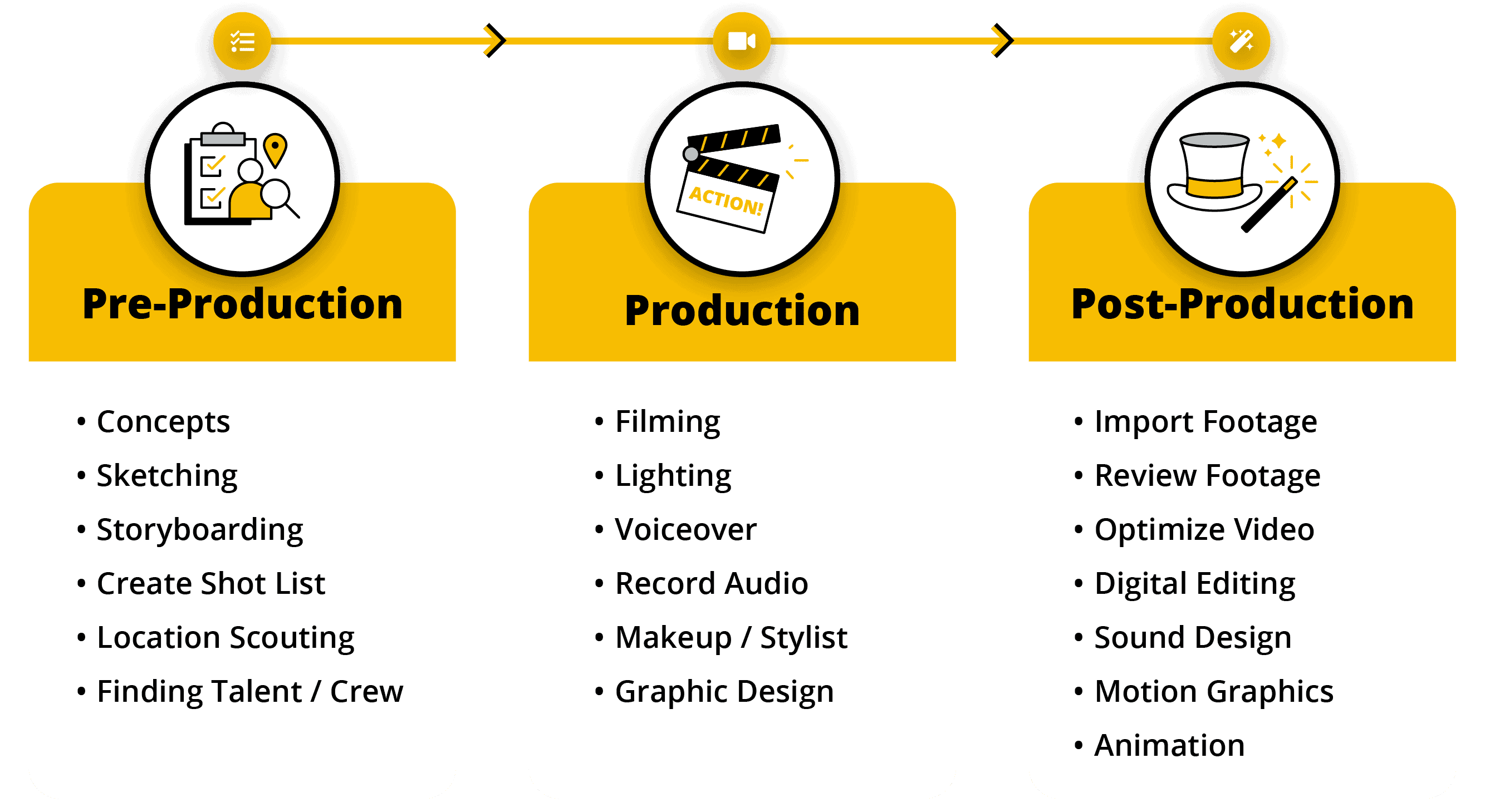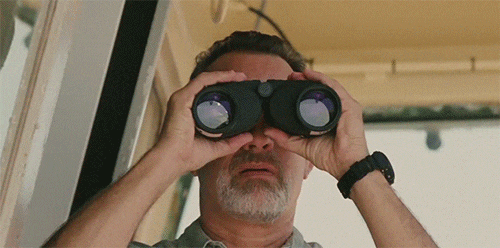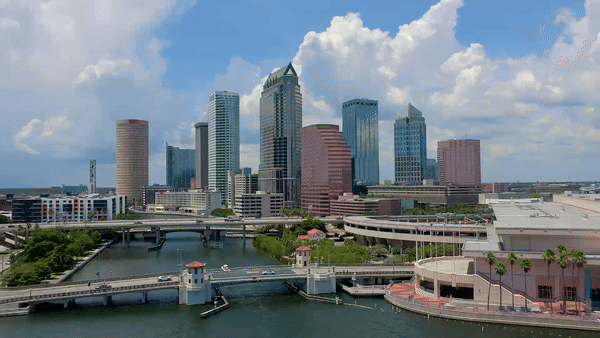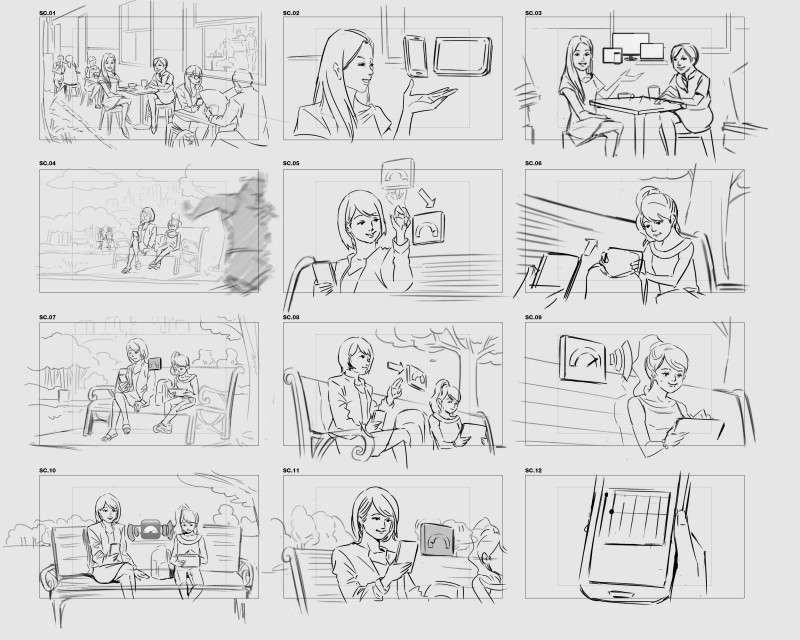This article was updated on 04/25/2025
Why Every Detail Matters in the Video Production Process
Let’s be honest—great videos don’t just appear by hitting the record button. Behind every polished, high-impact video is a smart, strategic process that starts long before the cameras roll. Whether you’re filming a quick testimonial or a full-blown brand film, knowing how the process works helps you ask the right questions, set realistic expectations, and avoid the budget-eating surprises that derail weaker projects. In this guide, we’ll walk you through every step of the video production journey—from the very first brainstorm to final delivery—so you’re never left wondering what happens next.
Table of Contents

Factors Affecting Video Production Costs
Understanding the video production process means feeling confident about how your investment is being used to bring your story to life. Costs can shift depending on your creative direction, goals, and the overall scale of the project—but knowing the moving parts gives you more control and peace of mind.
Some of the biggest cost factors in the video production process include:
- Concepts and Art Direction
- Script development and storyboarding
- Pre-production coordination and scheduling
- Location scouting and number of shoot days
- Permit acquisition for public filming locations
- Hiring professional talent or voiceover artists
- Hair, makeup, and wardrobe stylists (if needed)
- Sound stages or studio rentals
- Lighting and camera packages
- Original motion graphics or animation
Each of these can move the needle on your budget depending on complexity. For example, a multi-location shoot with high-end gear and original animation is going to cost significantly more than a one-camera testimonial filmed on-site.
Adding this kind of transparency to the video production process not only sets better expectations—it sets you up for smoother planning and smarter decisions.
Pre-Production: Where It All Begins
This is the blueprint phase—the part most people overlook, but where the real magic starts. Before a single frame is shot, every decision that shapes the success of your video happens right here. It’s about locking in your message, your people, your locations, and your timeline. Get this right, and the rest flows like clockwork.
- Clarifying Goals and Audience: Defining the purpose of the video, who it’s for, and what action you want viewers to take.
- Developing Scripts and Shot Lists: Writing clear, focused scripts and mapping out the key shots needed to tell the story visually.
- Creating a Production Schedule: Building a timeline that outlines shoot days, location moves, and crew call times to keep everything on track.
- Casting Talent (Internal or External): Choosing whether to feature your team members or bring in professional actors or voice talent to deliver the message.
- Securing Locations: Scouting and locking down the right settings, whether it’s your office, a rented venue, or a unique off-site location.
- Budget Planning: Breaking down all project costs—from crew and gear to permits and post-production—to stay aligned with your financial goals.
It’s also where the collaboration starts. The best video productions begin with an exchange of ideas between you and your creative team. Talk about your goals. Share examples. Get aligned.
At this stage, it’s helpful to decide if you’re using professional talent or employees. Both have their place. Employees can add authenticity. Pros can keep things moving on schedule.

Location Scouting: What Kind of Location Do You Need
If you’re not filming in your office or workspace, you’ll need a location that aligns with your brand’s tone and message. Platforms like Peerspace and Airbnb offer affordable, ready-to-use options that can range from $800 to $1,600+ per day or more. A good producer will help scout and secure the best space for both your budget and creative goals.
In some cases, you might need a professional sound stage—especially if you’re working with complex lighting setups, controlled audio environments, or large props. Need to drive a car indoors for a product demo? No problem. Sound stages are designed for exactly that kind of flexibility, offering everything from custom backdrops to high ceilings and rigging options.
If you’re filming in public or semi-public locations legal requirements can also influence the bottom line. Shooting in public may require filming permits, insurance, and strict adherence to safety protocols. A seasoned production company will manage those logistics—but it’s still important to factor them into your overall budget.
Video Script Writing and Storyboarding
The script is your blueprint. A clear, concise script helps communicate your core message quickly—especially important for brand videos under two minutes.
For instructional content or longer videos, more detailed scripting keeps things organized and on-point. Whether you’re heavy on VO or interviews, a pro copywriter can sharpen your message so it lands.
Storyboards or shot lists take things a step further. They help visualize the flow of the shoot and communicate how the finished video is imagined. Not every project needs a full storyboard, but even a simple written shooting schedule helps streamline the production day.
Video Production: Lights, Camera, Action
Now that the script is locked and the locations are scouted, this is where the rubber meets the road. This is the moment when all those ideas start coming to life. The producer will walk you through what to expect—covering the daily schedule, key milestones, and the full shooting timeline.
During the production phase, the real magic of filmmaking happens. To get professional-grade results, you need top-tier gear—cameras, lights, audio—and a seasoned video production company knows how to use it. High-end equipment isn’t optional if you want a look and feel today’s audiences expect.
It’s also crucial to have backups for every technical aspect of production. In most cases, you only get one shot, and there’s no time for equipment failures when you’re working against tight schedules and client budgets.
Some shoots involve a lot of moving parts and a bigger crew. That’s why communication is key—everyone on set needs to know the plan and stay sharp. Our goal is always to stay on time and on budget. And just as important, the crew needs to be in sync, working together without ego. We’ve been doing this since 2001, and we know firsthand: crew fidelity is one of the most important elements of a successful production.
Post-Production: Where the Magic Happens
This is where the raw footage transforms into something polished, purposeful, and powerful. Post-production is less about editing clips together—and more about shaping emotion, rhythm, and story into a final cut that actually delivers. The process starts with:
- Organizing and Reviewing Footage: Logging clips, creating proxies, and prepping the media for the edit.
- Assembling the First Edit: Rough cutting key scenes based on the script, storyboard, or shot list (also called a “first pass”).
- Cutting for Rhythm, Clarity, and Emotion: Fine-tuning pacing, building emotional beats, and tightening transitions for maximum impact.
- Color Correction and Grading: Balancing exposure and color for consistency (correction), then stylizing the look to match the project’s tone (grading).
- Audio Mixing and Sound Design: Cleaning dialogue, balancing levels, adding sound effects (SFX), and mixing the final audio track for clarity and mood.
- Motion Graphics and Animation (if needed): Designing and animating text, logos, lower thirds, infographics, or custom animated sequences.
- Revisions and Final Delivery Formats: Applying client feedback, polishing edits, and exporting deliverables optimized for web, social, or broadcast.
A well orchestrated post process is collaborative. Feedback loops with your team and editor ensure your message stays on point and the final product reflects your brand and vision.
Types of Videos You Can Produce
Not all videos are created equal—and that’s a good thing. From hype-building promotional videos to trust-earning testimonials, every type of video serves a different purpose. Here are a few formats that get results:
- Brand Videos Tell your story with purpose. Brand videos reveal your company’s heart, mission, and values—creating emotional connections that turn viewers into loyal customers.
- Corporate Videos From internal communications and onboarding to training and B2B outreach, corporate videos make complex messaging clear and engaging across your organization and beyond.
- Promotional Videos helps your audience see your value, feel your story, and trust your offer. Whether you’re launching a product or running a campaign, these videos can educate, inspire, and convert—in under two minutes. That’s power.
- Product DemosBreak down your product’s features and benefits with clarity and style. Great demo videos don’t just explain—they show why it matters and how it works.
- Testimonial Videos Real stories, real impact. Testimonial videos build trust and social proof with authentic voices. Want to level up? Add multi-camera setups, motion graphics, or dynamic editing for more polish and power.

Drone Video: Look Ma I’m Flying
Drone photography, once a luxury for big-budget productions, is now accessible to nearly any business looking to enhance their marketing videos. Stunning aerial shots—like zooming over oceans or capturing the sunrise on a skyscraper—can add a cinematic quality to your video marketing content. It’s also one of the best ways to establish a shot. Think of a wide shot panning down in the air to reveal your location.
However, not all drones or operators are created equal. High-end drones capable of carrying cinema-quality cameras require skilled operators who know how to manually control camera settings and understand composition and pacing. Before hiring, ensure the drone photographer has the expertise to capture smooth, professional footage that aligns with your brand’s story. Balancing impressive aerial shots with relatable, intimate moments is key to a successful video, so always discuss how the drone video footage will fit into your overall narrative.

Video Distribution: Show the World
You’ve put in the work—strategy, scripting, shooting, editing. Now it’s time to make sure your video actually gets watched. Distribution isn’t a final step—it’s part of the strategy. This is where you expand your reach, drive traffic, and convert attention into action.
A great video with poor distribution is like throwing a party and forgetting to send invites. So plan your rollout like you planned your shoot: intentionally, platform by platform.
Some ideas:
- Social media: Short-form, native-first, CTA-driven
- Email campaigns: Video boosts click-through rates by up to 65%
- YouTube & SEO: Optimize your title, description, and tags
- Landing pages: Video can increase conversion rates by 80%
Tailor your approach based on where your audience hangs out. Always pair your video with a clear call to action and tracking tools to measure success.

It’s a Wrap!
Video isn’t just about visuals—it’s about strategy. Understanding the full process—from scripting to final cut—makes you a better collaborator and leads to stronger, more effective content. Whether you’re working with a small crew or a full production team, being informed sets the stage for a video that delivers results.
Need a video produced? Schedule a free consultation with Mighty Fine Production Company today.

